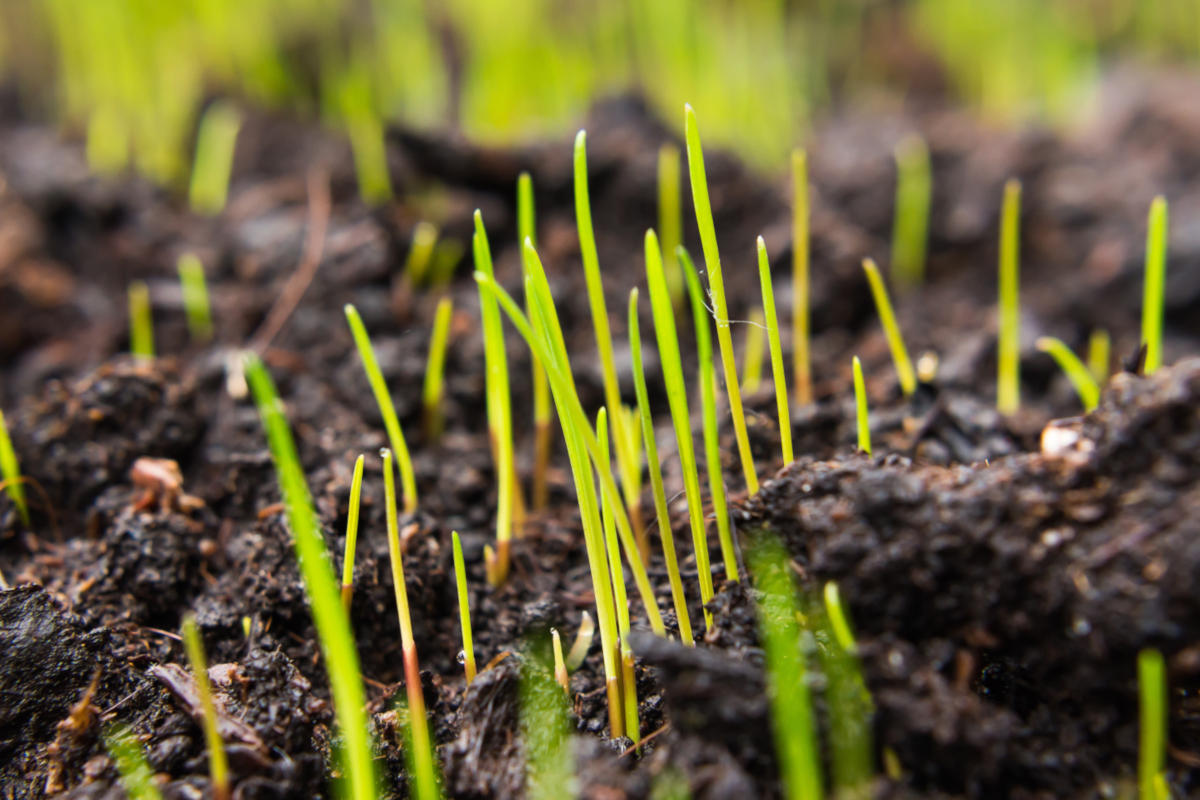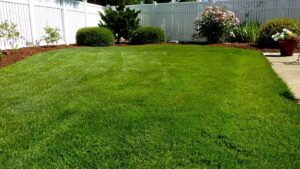How to Use the Grass Seed Calculator
Whether you’re looking to revamp your garden with a fresh, lush lawn or planning to overseed for a fuller, healthier yard, our Grass Seed Calculator is here to help! This handy tool calculates exactly how much grass seed you need, taking the guesswork out of your shopping. Whether you’re a beginner or an expert gardener, use the calculator to plan your seeding process efficiently, ensuring your lawn looks its absolute best. From small patches to large areas, this tool makes lawn care simple and effective, helping you achieve a vibrant, green yard.
Grass Seed Calculator
Using the grass seed calculator is a breeze and helps you determine exactly how much seed you need to plant or overseed your lawn. Follow these simple steps to get started:
- Select the shape of your lawn:
- Rectangular lawn: Input its width and length.
- Circular lawn: Input the radius.
- Elliptical lawn: Input the lengths of axis A and axis B.
- Triangular lawn: Input the base and height.
- Calculate the area:
If you want to understand how the area is calculated, you can use our area calculator. - Determine the seed amount:
Input the seed’s coverage rate, which is usually found on the seed package. The grass seed calculator will tell you how many pounds or kilograms of seed you need based on the area you’ve calculated.
Example of Using the Grass Seed Calculator
Let’s say you want to plant a circular lawn with a radius of 50 feet. First, you calculate the area of the circle:
$$[\text{Area} = π \times \text{radius}^2]$$
$$[\text{Area} = π \times (50 \text{ ft})^2 = 7,854 \text{ ft}^2]$$
Next, if the grass species you selected has a coverage rate (CR) of 5 pounds per 1000 square feet, you can use the following formula to calculate the required seed amount:
$$[\text{Seed amount} = \text{coverage rate} \times \frac{\text{area}}{1000}]$$
$$[\text{Seed amount} = 5 \times \frac{7,854}{1000} = 39.35 \text{ lbs}]$$
So, you would need 39.35 pounds of grass seed to cover the area.
Area Formulas for Different Lawn Shapes:
- Rectangle area: width × length
- Ellipse area: axis A × axis B × π
- Triangle area: ½ × height × base
Understanding the Coverage Rate
The coverage rate varies depending on the type of grass you are planting and whether you are starting a new lawn or overseeding an existing one. You can find this value on the grass seed packaging, and it’s essential to calculate the right amount to avoid under- or over-seeding.
Coverage Rates for Popular Grass Types:
| Grass Type | New Lawn CR (lbs/1000 ft²) | Overseeding CR (lbs/1000 ft²) |
|---|---|---|
| Buffalo | 3 | 1.5 |
| Creeping Red Fescue | 5 | 2.5 |
| Fine Fescue | 5 | 2.5 |
| Kentucky Blue Grass | 4 | 2 |
| Tall Fescue | 10 | 5 |
By following these simple calculations, you can ensure that your lawn receives the right amount of seed for optimal growth, whether you’re planting a new lawn or improving an existing one.
Grass Seed Calculator – Example
Let’s walk through an example to calculate the grass seed needed for your lawn:
Suppose you’re planning to seed a circular lawn with a radius of 50 feet. To determine the area of this circle, you would use the following formula:
$$[\text{Area of circle} = \pi \times \text{radius}^2]$$
Substitute the values:
$$[\text{Area} = \pi \times (50 \, \text{ft})^2 = 7,854 \, \text{ft}^2]$$
Next, to calculate the quantity of grass seed required, you’ll need the seed’s coverage rate (CR), which is typically measured in pounds per 1000 square feet. Let’s assume the CR for your grass type is 5 pounds per 1000 square feet. Using this value, you can calculate the total seed requirement:
$$[\text{Seeds} = \frac{\text{Coverage rate} \times \text{Area}}{1000}]$$
Substituting the numbers:
$$[\text{Seeds} = \frac{5 \times 7,854}{1000} = 39.35 \, \text{lbs}]$$
Therefore, for a circular lawn with a radius of 50 feet, you would need to purchase approximately 39.35 pounds of grass seed.
For other lawn shapes, the area calculations differ:
- Rectangle: $$(\text{Area} = \text{Width} \times \text{Length})$$
- Ellipse: $$(\text{Area} = \pi \times \text{Axis A} \times \text{Axis B})$$
- Triangle: $$(\text{Area} = \frac{1}{2} \times \text{Base} \times \text{Height})$$
These formulas help you accurately determine the amount of grass seed required for different lawn shapes.
Introduction to Grass Seed Calculations
When planning to plant or overseed a lawn, determining the right amount of grass seed is crucial for achieving a healthy, lush lawn. Whether you’re working with a large pasture or a small backyard, understanding the relationship between seed quantity, coverage area, and grass type ensures successful results. This guide will explore various aspects of grass seed measurement and calculations, providing insights into seed coverage, charts, and formulas.
Grass Seed 10 kg
Grass seed typically comes in a variety of package sizes, and a 10 kg bag is commonly used for medium-sized lawns or specific applications. Knowing how much area a 10 kg bag of grass seed will cover depends on the type of grass seed and its coverage rate. For example, fast-growing varieties like ryegrass might require a higher seeding rate, while finer grasses such as fescue may need less. To maximize efficiency, you’ll need to calculate the total area to be seeded and compare it with the grass type’s coverage rate. A 10 kg bag may be enough for a new lawn or overseeding, depending on the size of the area.
Grass Seed Per Acre Chart
A grass seed per acre chart provides guidance on the amount of seed required for different grass types per acre. The chart typically lists various types of grass, such as Kentucky Bluegrass, Bermuda, or Tall Fescue, and the corresponding seeding rate in pounds or kilograms. These charts are especially useful for larger projects like pastures, golf courses, or expansive lawns, where precision is essential. For example, a typical seeding rate for Kentucky Bluegrass might be 40-60 pounds per acre. By referencing this chart, you can avoid both under-seeding, which can lead to patchy growth, and over-seeding, which can waste seed and increase costs.
Calculate Grass Seed Needed
To calculate the grass seed needed, you must know the size of the area and the seeding rate of the specific grass variety you plan to plant. The seeding rate is usually provided on the seed packaging or can be obtained from a reliable source, such as an agricultural extension office. Once you know the size of the lawn or area and the recommended seeding rate, you can calculate the total amount of seed required. The basic formula is:
$$[\text{Grass Seed Needed} = \frac{\text{Area (in sq ft or m2)} \times \text{Coverage Rate}}{1000}]$$
This formula provides a straightforward method for determining how much grass seed to purchase.
Grass Seed Coverage Chart
A grass seed coverage chart shows how much seed is needed for different grass types based on the area being seeded. This chart provides coverage rates in terms of pounds or kilograms per 1,000 square feet or per acre. It takes into account factors such as grass type, lawn condition, and whether you are establishing a new lawn or overseeding. By consulting a coverage chart, you can ensure that you’re applying the correct amount of seed for optimal results. These charts are invaluable for both amateur gardeners and professionals.
Grass Seed Calculator for Overseeding
Overseeding is the process of spreading grass seed over an existing lawn to improve its density and health. A grass seed calculator for overseeding helps determine how much seed is needed to fill in bare spots or thicken the turf. Overseeding usually requires less seed compared to planting a new lawn, as the goal is to complement existing grass rather than establish a completely new growth. By inputting the lawn size and overseeding rate into the calculator, you can determine the exact amount of seed required.
Grass Seed Calculator Per Acre
A grass seed calculator per acre is a tool designed to help you determine how much seed is required to cover an acre of land. Whether you’re sowing a large field or a section of pasture, the calculator helps you account for seed type, application method, and coverage rate. For example, a seeding rate for Tall Fescue might be around 10-15 pounds per acre, while Bermuda grass might require more. Using this calculator ensures accuracy in seed distribution and cost management.
Grass Seed Per m2
Grass seed per m2 refers to the amount of seed required to cover one square meter of lawn or field. The seeding rate per square meter varies by grass type and lawn condition. Fine grasses may require as little as 20-30 grams per square meter, while coarse grasses may need up to 50 grams. Calculating the seed required per m2 is especially useful for small gardens or precise overseeding tasks.
How Much Grass Seed Per m2
The amount of grass seed needed per square meter depends on factors like grass type, the purpose (new lawn or overseeding), and soil conditions. A typical recommendation for a new lawn might be 25-50 grams per square meter, but overseeding could require less, around 15-25 grams per square meter. By calculating how much seed per m2 you need, you can ensure uniform coverage and avoid wasting seed.
In conclusion, whether you’re working with a small patch of lawn or a large acreage, understanding grass seed coverage and the correct amount of seed is essential for successful lawn care. By utilizing calculators and charts, you can ensure optimal seeding and a healthy, green lawn.




